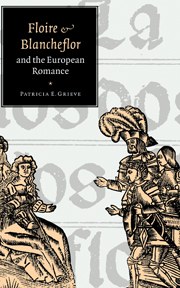Epilogue: Poetics of continuation
Published online by Cambridge University Press: 15 December 2009
Summary
This part of the study explores the poetics of continuation from a variety of perspectives, theoretical as well as chronological. The first section examines the notion of continuations, sequels or potential sequels through the introduction of the progeny of Floire and Blancheflor. The second section deals with the Middle English pious romance, Emaré, and the significance of the reference to Floire and Blancheflor within the story. In the third section, I briefly discuss Keats's awareness and borrowing of the love story for his “Eve of St. Agnes.” The fourth section introduces a fascinating topic that far exceeds the scope of this study: the pervasive influence of Floire and Blancheflor in Hispanic balladry, from the Middle Ages through the twentieth century. Finally, I discuss briefly the influence of Floire and Blancheflor on courtship and conjugal patterns in late twentieth-century Spanish society.
In France, Germany and England, the union of Floire and Blancheflor produced a single heir, Berthe, whose fame rests, aside from being Berthe “au grand pie,” on being the mother of Charlemagne. In the Old Norse-Icelandic riddarasaga, Flóres saga ok Blankiflúr, Flóres and Blankiflúr produce no heir, but they do found a monastery and a nunnery. A later riddarasaga, Sigurdar saga pögla, modifies the legend to describe the couple's only child, Sendentíana, who becomes one of Frakkland's famous maiden-kings.
- Type
- Chapter
- Information
- 'Floire and Blancheflor' and the European Romance , pp. 182 - 201Publisher: Cambridge University PressPrint publication year: 1997



